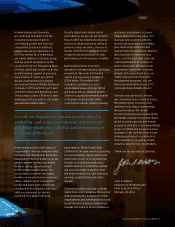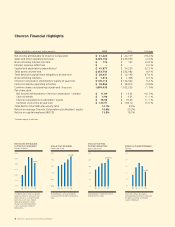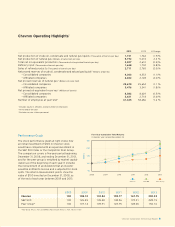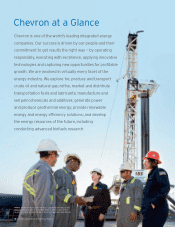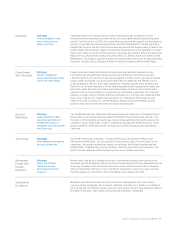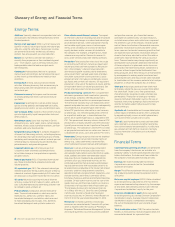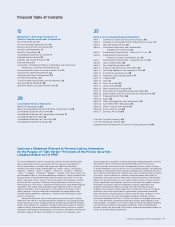Chevron 2013 Annual Report Download - page 15
Download and view the complete annual report
Please find page 15 of the 2013 Chevron annual report below. You can navigate through the pages in the report by either clicking on the pages listed below, or by using the keyword search tool below to find specific information within the annual report.Chevron Corporation 2013 Annual Report 13
related to these seeps have emerged. A Brazilian federal district
prosecutor led two civil lawsuits seeking $10.7 billion in
damages for each of the two seeps. On October 1, 2013,
the Court dismissed the two civil lawsuits and approved a
settlement under which Chevron and its consortium partners
agreed to spend approximately $43 million on social and
environmental programs. On November 11, 2013, the Court
announced that the settlement is nal. e federal district
prosecutor also led criminal charges against Chevron and
eleven Chevron employees. On February 19, 2013, the court
dismissed the criminal matter, and on appeal, the appellate
court reinstated two of the ten allegations, specically those
charges alleging environmental damage and failure to provide
timely notication to authorities. e company is assessing its
legal options. e company’s ultimate exposure related to the
incident is not currently determinable, but could be signicant
to net income in any one period.
Downstream Earnings for the downstream segment are
closely tied to margins on the rening, manufacturing and
marketing of products that include gasoline, diesel, jet fuel,
lubricants, fuel oil, fuel and lubricant additives, and petro-
chemicals. Industry margins are sometimes volatile and can
be aected by the global and regional supply-and-demand bal-
ance for rened products and petrochemicals and by changes
in the price of crude oil, other renery and petrochemical
feedstocks, and natural gas. Industry margins can also be
inuenced by inventory levels, geopolitical events, costs of
materials and services, renery or chemical plant capacity uti-
lization, maintenance programs, and disruptions at reneries
or chemical plants resulting from unplanned outages due to
severe weather, res or other operational events.
Other factors aecting protability for downstream opera-
tions include the reliability and eciency of the company’s
rening, marketing and petrochemical assets, the eectiveness
of its crude oil and product supply functions, and the volatility
of tanker-charter rates for the company’s shipping operations,
which are driven by the industry’s demand for crude oil and
product tankers. Other factors beyond the company’s control
include the general level of ination and energy costs to oper-
ate the company’s rening, marketing and petrochemical
assets.
e company’s most signicant marketing areas are the
West Coast of North America, the U.S. Gulf Coast, Asia and
southern Africa. Chevron operates or has signicant ownership
interests in reneries in each of these areas.
Refer to the “Results of Operations” section on pages
14 through 16 for additional discussion of the company’s
downstream operations.
All Other consists of mining operations, power and energy
services, worldwide cash management and debt nancing activi-
ties, corporate administrative functions, insurance operations,
real estate activities, alternative fuels, and technology companies.
Operating Developments
Key operating developments and other events during 2013
and early 2014 included the following:
Upstream
Angola First shipment of liqueed natural gas was made
from the Angola LNG Project.
Argentina Signed agreements advancing the Loma
Campana Project to develop the Vaca Muerta Shale.
Australia Signed binding long-term LNG Sales and
Purchase Agreements with two Asian customers. Binding
long-term agreements now cover 85 percent of Chevron’s
equity LNG otake from the Wheatstone Project.
Announced two natural gas discoveries in the Carnarvon
Basin. ese include discoveries at the 50 percent-owned and
operated Kentish Knock South prospect in Block WA-365-P
and the 50 percent-owned and operated Eln prospect in
Block WA-268-P.
Reached agreement to acquire interests in two onshore
natural gas blocks in the Cooper Basin region of central
Australia.
Acquired exploration interests in two blocks located in
the deepwater Bight Basin oshore South Australia.
Brazil Conrmed the start of crude oil production from
the Papa-Terra Field.
Awarded participation in a deepwater block in the Ceará
Basin.
Canada Announced an agreement to acquire additional,
complementary acreage in the Duvernay Shale.
Announced the successful conclusion of the initial
twelve-well exploration drilling program in the liquids-rich
portion of the Duvernay Shale located in western Canada.
Kurdistan Region of Iraq Announced the acquisition
of an 80 percent interest and operatorship of the Qara Dagh
Block.
Republic of the Congo Announced the nal investment
decision on the deepwater Moho Nord Project.
United States Announced a joint development agree-
ment for additional Delaware Basin acreage and access to
related infrastructure.
Announced a crude oil discovery at the Coronado pros-
pect in the deepwater Gulf of Mexico.
Announced a successful production test of a St. Malo
well in the deepwater Gulf of Mexico.


